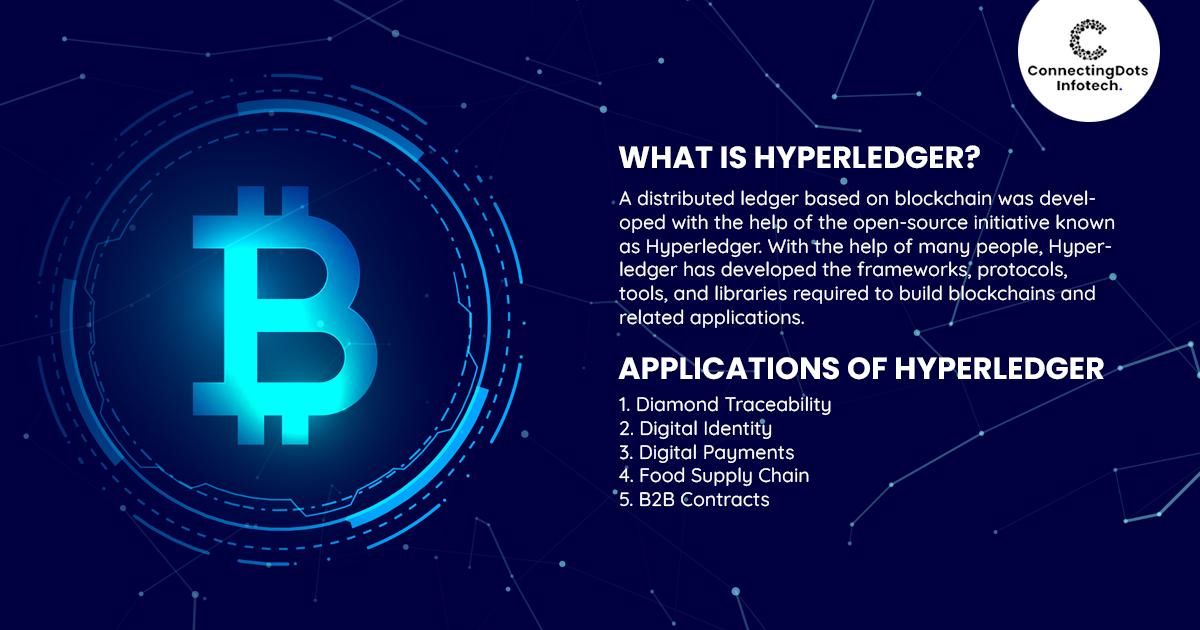Hyperledger In Blockchain

The development and proliferation of blockchain technology have provided some compelling evidence of the technology's potential. Hyperledger Blockchain has distinguished itself among the various well-liked blockchain frameworks by building a distinctive name for itself. A lot of ambitious blockchain experts want to learn how to use Hyperledger Blockchain apps and put them into practice.
In 2016, Hyperledger became widely known as an open-source group of initiatives and tools made primarily for automating blockchain development processes. Better communication between developers and companies using distributed ledger technology was crucial for Hyperledger's effectiveness.
What is Hyperledger?
A distributed ledger based on blockchain was developed with the help of the open-source initiative known as Hyperledger. With the help of many people, Hyperledger has developed the frameworks, protocols, tools, and libraries required to build blockchains and related applications.
Since Hyperledger was founded by the Linux Foundation in 2016, companies like IBM, Intel, Visa, American Express, Samsung, Microsoft, and blockchain start-ups like Blockforce have all contributed to the project. All told, the relationship spans the manufacturing, IoT, banking, supply chain management, and production-based industries.
Various distributed ledger frameworks and libraries are brought together by Hyperledger. With this, a company may, for instance, employ one of Hyperledger's frameworks to enhance the effectiveness, speed, and transactions of its business processes.
The way that Hyperledger functions is by offering the infrastructure and standards required for creating blockchain systems and applications. The concepts and tools that make up Hyperledger are used by developers to create business blockchain initiatives. Participants in the network are all familiar with one another and can take part in consensus-building procedures.
What are the Applications of Hyperledger?
1. Digital Identity
A Hyperledger Blockchain app tutorial's overview would be lacking without a mention of the use cases for digital identification. With the sharp rise in data breaches and cyberattacks, businesses are gradually recognising the flaws in data and network security.
The demands of robust security cannot be met by traditional network security methods. As a result, businesses are turning to blockchain technology to protect important data. Utilizing Hyperledger Blockchain as a permissioned blockchain could be useful in implementing effective access control for digital credentials.
2. Digital Payments
Digital payments are another prominent example of a Hyperledger Blockchain application. A decentralised private blockchain network featuring a feature for safe transactions between two parties is offered by Hyperledger. A distributed ledger for the banking industry called Interledger will also be launched by Hyperledger Blockchain.
It would take advantage of the idea of creating various ledgers for simpler transaction processing via comparable channels. The uses of Hyperledger Blockchain in Interledger demonstrate how quickly such systems may be created. Additionally, it can guarantee effective communication between the various payment systems.
Applications for Hyperledger, such as Interledger, may establish new standards for the finance industry. With the help of Interledger, anyone can send money to anyone else for a negligible fee. The ability to make cross-border transactions between two parties without requiring accounts on particular payment providers is the most crucial aspect of all.
3. B2B Contracts
B2B contracts would be the final addition to the list of Hyperledger Blockchain application examples. Businesses can do away with the requirement for commercial contracts to be codified, which will encourage the automation of contractual agreements. B2B contracts are regarded as one of the best examples of a Hyperledger Blockchain application because they provide enough room for value-based rewards. Smart contracts could be used by businesses to enable the automation of contractual agreements between several parties.
Additionally, the blockchain's cryptographic features can aid in protecting the data in contracts between two or more parties. The most advantageous features in this situation are provided by Hyperledger Blockchain's network-within-network framework. The information in B2B contracts is totally safe thanks to the different channels for communication between the parties.
4. Diamond Traceability
One of the major problems facing organisations today is how to trace costly products. Diamonds, for instance, are among the most valuable natural resources. However, the diamond mining industry is highly challenging because numerous parties must be involved before the gems can be sold.
In order to address the issues of fraud and double-spending in the diamond mining industry, Hyperledger applications may be useful. The same holds for several sectors, including the production of jewellery and high-end clothing. What benefits will Hyperledger Blockchain provide in these use cases?
Consider the diamond mining industry as an example. With the aid of Hyperledger Blockchain, the agents engaged in the diamond mining industry can come together to form a consortium. The blockchain framework can assist in tracking and recording all transactions, maintaining the process' overall transparency.
5. Food Supply Chain
The control of the food supply chain is developing as the largest use case for Hyperledger Blockchain. Hyperledger has been used by numerous businesses from a variety of industries to track product production throughout the manufacturing process. The lesson for the Hyperledger Blockchain application would also demonstrate how businesses actively use the platform for creating consortiums.
It's interesting to note how many businesses have been using Hyperledger to track products throughout the entire manufacturing process. Businesses use Fabric to build consortiums that can enhance the food supply chain while also winning over customers.
Authorized users have access to data on the food supply chain using Hperledger Fabric according to their preferences. Users could view every food item's whole history as well as its current position. These systems can make it easier to locate the source of faults.

Conclusion
A relatively recent method of addressing these issues and building a system that is exceptionally safe and secure is blockchain. It is fundamentally altering how various sectors operate. Businesses are increasingly using blockchain, a new type of database, to protect customer data. A decentralised permission blockchain was the ideal answer, as a result. An enterprise blockchain is designed specifically to handle organisational needs at the enterprise level. It is a blockchain network that companies may use to increase the impact they have on customers.
